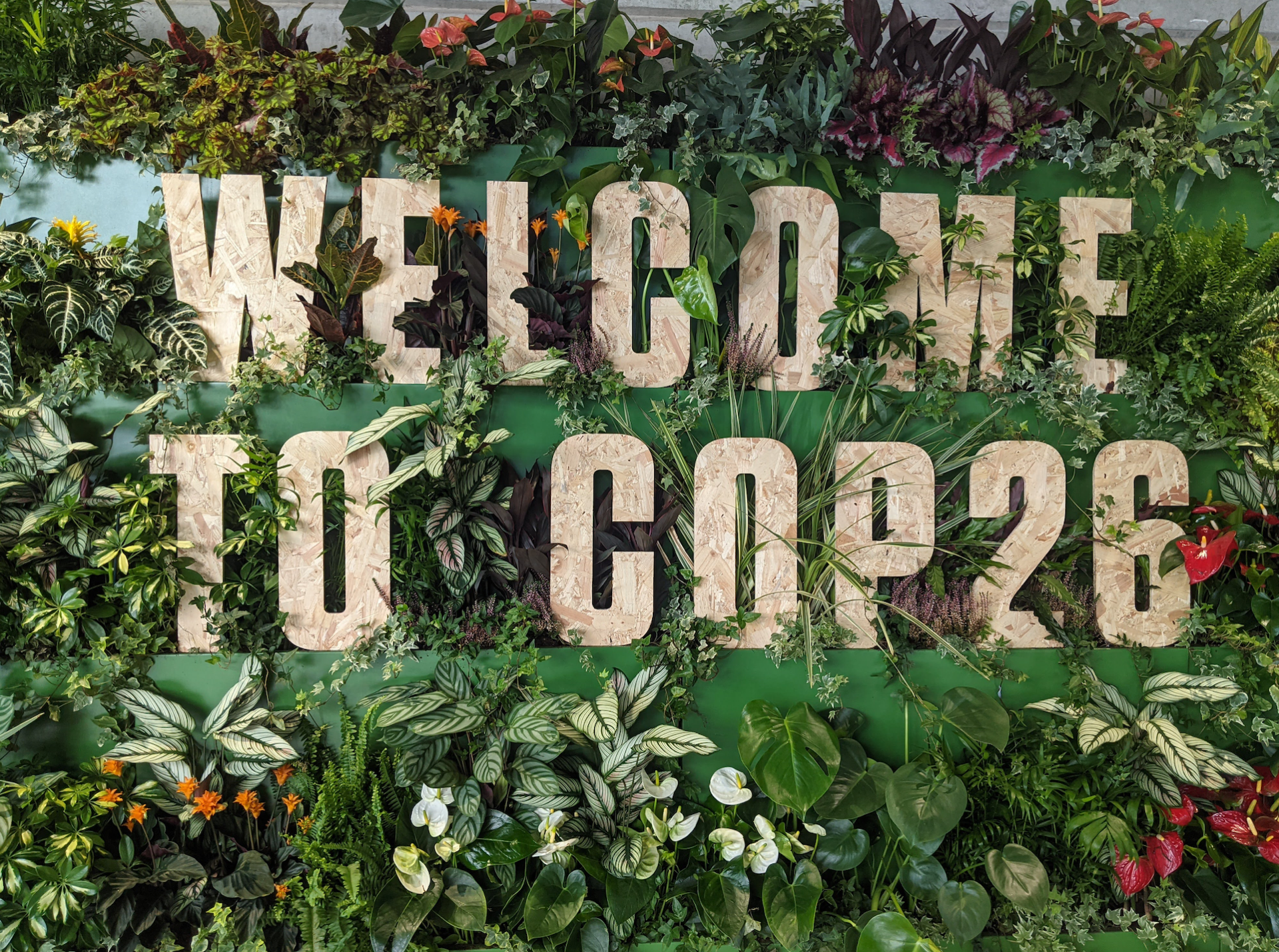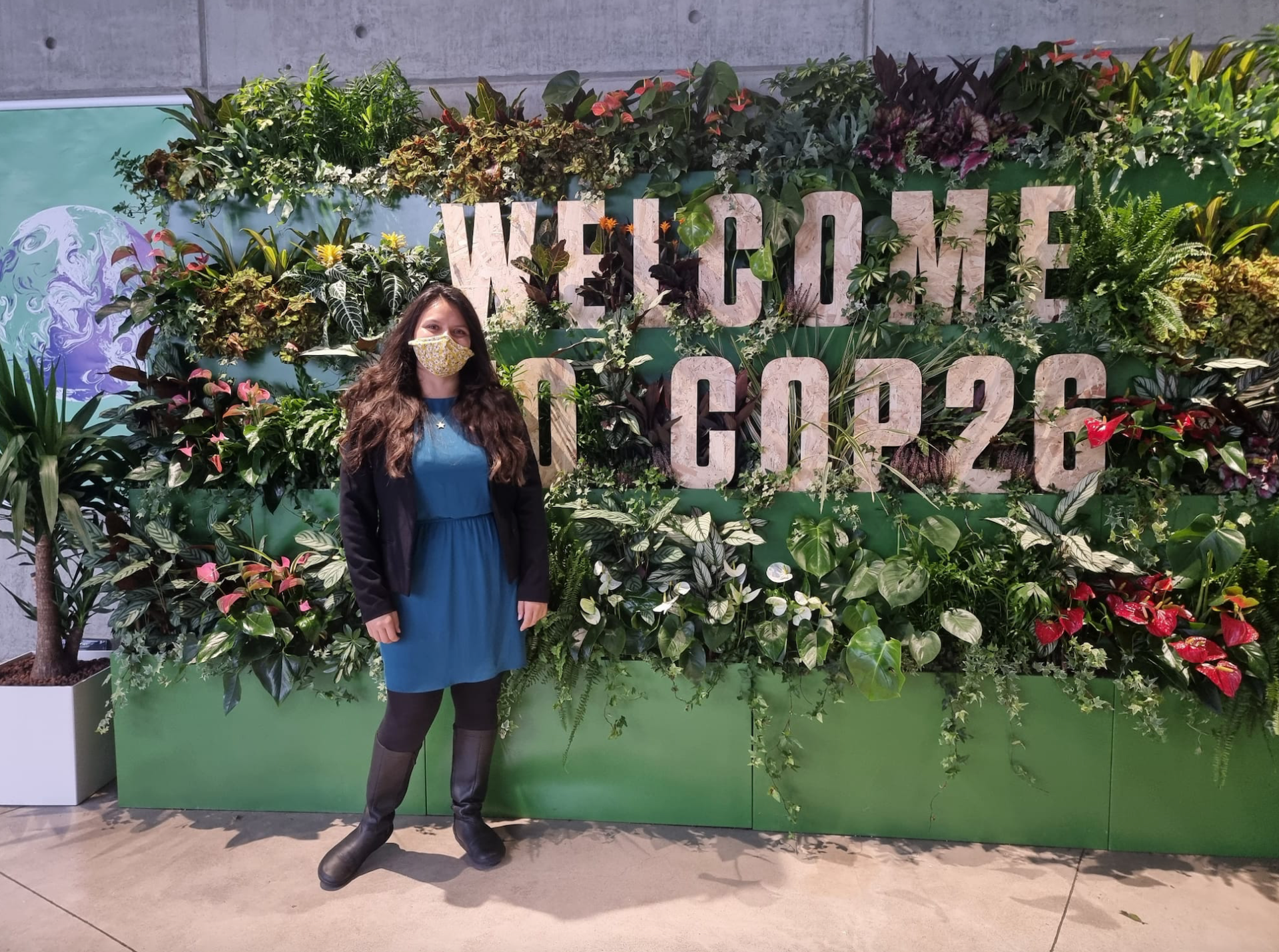
“I’m a bit all over the place with anger, frustration, inspiration, pride, and optimism”
Fresh from a week at @COP26, we caught up with PGR Olivia Reddy to find out what she got up to at the conference, what she learnt about climate justice and how it might impact her research.
Before we get started on COP26 and climate action, can you tell us about your area of research at Bristol?
I’m in my second year of my PhD in Civil Engineering, researching “Onsite Sanitation Systems: How Infrastructure and Management Effects Resilience and Emissions”. I’m really lucky as I am working in a team as part of the SCARE project, which looks at sanitation, climate change and resilience across low- and middle-income countries, conducting fieldwork in Nepal, Ethiopia, Senegal, and Uganda. I have colleagues from institutions all over the world in countries with landscapes and cultures so different to my own.
How did you end up going up to COP26? What were you hoping to do there?
If I’m honest, at the beginning of the year I hadn’t thought much about COP26 in ways other than “the climate thing that was postponed because of COVID?”! But after hearing about it in project meetings, I started looking into it more, before taking part as a facilitator in a mock-COP26 for school children, run in partnership with the Cabot Institute. As I began to understand the importance of the conference, I saw that the SU was running a scheme for students to travel to COP26. My hope was to come back with a better understanding of the conference, the process, and the different types of people involved.

We’ve heard a lot about COP26 on the news, but what is it like actually being there?
It’s different for everyone! As well as the official blue and green zones, there’s protests, activism, fringe events (such as The Extreme Hangout on a boat), music, art, culture, workshops… Everyone who attended COP26 will have had a different experience.
Hold up – what is the difference between the blue and the green zone?!
The blue zone is the political part – you have to be invited. The green zone is the public part – open to all, you just needed to register for a free ticket.
Ah ok. Thanks. So where did you spend most of your time?
Inside the green zone, I was lucky to attend quite a lot of events, so I spent most of my days going to talks and looking through the stands and other exhibits at Glasgow Science Centre. The 20 minutes to get through airport-style security, was nowhere near as bad as I was expecting. The science centre had been decorated with COP26 logos and the colour green almost everywhere you looked, whether as lights, paint, or foliage. There was also, disappointingly, a large amount of greenwashing from the big sponsor organisations.
What did your days involve?
I spent a lot of time sitting in awe and wonder, either inside a talk, chatting to the speakers afterwards, or trying to take it all in while having a snack break. The passion from the speakers is something that I had never experienced before. A lot of my time was spent juggling all the conflicting emotions which seemed to be stirring inside me. Hearing the lack of progress from negotiations in the blue zone, the anger associated with it that seemed to reverberate around the room, coupled with the power, strength and courage shown by people from indigenous communities, island nations, low- and middle-income countries, who are living the effects of climate change right now. A lot of my time was spent on the edge of tears, both good and bad.
If you want to catch up on any of the events that have happened, many are up on YouTube (such as the Official COP26 page) or linked to on various Twitter accounts.

Can you tell us a bit about ‘climate justice’? How does this approach differ to more general talk about climate change?
Climate change is not just an environmental issue but covers ethics, accessibility, economics, wealth, health and wellbeing, all aspects of life. Climate justice takes this into consideration and centres the experience of those at the sharp end of the climate crisis.
I guess we all know in the back of our heads that climate change = melting ice caps = rising sea levels = loss of coastal land and islands, but have you ever actually thought about that last part properly? Listening to Diwi Valiente from Panama as he spoke about his community being the first indigenous peoples to be displaced by climate change made me realise that I hadn’t thought about it enough. Here’s a community that has lost everything, shops, neighbours, families, religious groups, social circles – all displaced. A community that produces less than 1% of global emissions is consistently in the top 10 countries to be suffering from the impacts of climate change. The injustice of it all.
Similarly, listening to Ruth Miller, Climate Justice Director for Native Movement in Alaska, talk about the subsistence salmon fishing undertaken by arctic and sub-arctic communities such as the one she is part of. Making up around 30% of their total protein intake, they fish in the summer, then smoke and dry the fish so that they have food for the winter. But this year, due to overfishing and trawling further downstream, the community were unable to fish as the population was too low. They will go hungry this winter because people in the West – or richer countries – want McDonald’s fish sandwiches. This is not just.
What does this mean for countries and organisations calling for Climate Justice rather than, for example, mitigation – what are some of the policies or agreements that are needed?
I am by no means an expert, but I have learnt so much from the people I met and listened to at COP26. One of the big conversations (with a very disappointing outcome) from COP26 was Loss and Damage. Essentially, poorer nations that are already experiencing the effects of climate change were asking for reparations from the richer nations who are the drivers of climate change. This would be a start. Loss and damage, in addition to aid and climate financing would at least provide monies for adaptation and mitigation projects.
Salina Sanou from the Pan African Climate Justice Alliance emphasised the need for the promised billions of dollars from rich nations, but also the manner of its delivery. Currently many projects work on the basis of “high return in investment” when in reality they should be more like social enterprises, building up the communities, especially where women and girls are concerned.
What did you learn from COP26? Do you think it will affect your research going forward?
I’ve learnt so much more than I thought I would, including;
- Learning from and listening to those from indigenous communities is essential to work out the best ways to move forward. I’m going to try and reflect this in my work somehow.
- Amplifying the voices of those who are not often heard. I like to think I’ve already started on this journey by encouraging some of my old colleagues to include this in a “ways to help prevent climate change” show they were presenting at COP26. It may be a small step, but this message would have reached over 200 people in 3 days – which I think is quite good!
- Using more open access and easy read formats where available. Being able to read a paper online is something that we take for granted here at the University of Bristol. But if you are trying to access this information as a member of the public or as someone with a learning disability, fees and formats become a massive barrier.
These are only a few things; I know there are so many more.
Anything else you’d like to share?
You can probably tell from the tone of this conversation that I’m a bit all over the place with anger, frustration, inspiration, pride, and optimism. I think a lot of us are, and a lot of people are exhausted.
But if I’ve learnt anything, it’s that there are more people in the world who want to make a difference and for things to change, than there are those who decide to ignore that our house on fire. COP26 was not the end, it was just the start.

